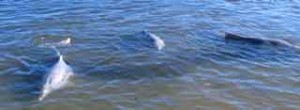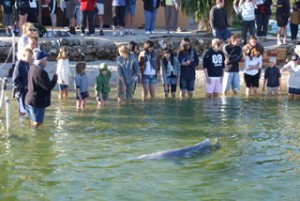Dolphin Watching
4WD Hire Dolphin Watching also What to expect
Tin Can Bay 2 Fraser Island
The dolphins generally also arrive early so plan to be here some time between 7.00am and 8.00 am.
On arrival visitors are also welcome to join the volunteers in the water and get to know these beautiful mammals.
Feeding commences at 8.00am with a small group of people also in the water at one time.
Also feeding fish is also available at the site.
As a volunteer group we also request $10.00 per person entry fee
plus $10.00 to cover the cost of each fish purchased and also our other costs.
Dolphin feeding does mean getting wet, at least up to your knees also come prepared!
Once the dolphins are fed they also generally return straight to the wild to get on with their day
so be sure to be there before 8.00 am to give yourself the best chance of enjoying also this wonderful experience.
Of course, these animals are also wild so we cannot guarantee their arrival time or even that there will be dolphins on a given day.
However, patience is often rewarded when they are late so order some refreshments from the cafe and also sit back, relax and enjoy the scenery.
It is rare for no dolphins to visit but as with all wildlife experiences it can also happen.
Most of all also enjoy yourselves and don’t forget to tell your friends and family about our beautiful dolphins and the spectacular Cooloola region.
Caring for the dolphins
There are some rules and regulations we ask our visitors to abide by to ensure our dolphins stay healthy and remain wild
- Only fish purchased at the site can be fed to the dolphins (a maximum of 3kg per dolphin is fed each day)
- Please ensure the flash on your camera is switched off to avoid potential injury to the dolphins eyes
- Swimming with, or touching the dolphins is prohibited by law with penalties of up to $8,000 applying.
- Do not enter the water unless accompanied by a volunteer
- Also Dogs are not permitted
- If using a mobile phone for photos please also switch it to silent mode.
The dolphin feeding is also regulated by the Queensland Government with a group of volunteers
on site to ensure it is an enjoyable experience for both humans and dolphins.
About the dolphins
Scientific name
Sousa Sahulersis
The Australian Humpback Dolphin as of the 1st August 2014 was also recognized World Wide as a species on its own,
as of that date no population estimate is available so still classified rare.
The specific name of Sousa Sahulersis is derived from the Sahul Shelf an underwater shelf located
between Northern Australia and Southern New Guinea where the Australian Humpback Dolphins occur.
As scientifically described on 31st July 2014 in the Marine Mammal Science Journal
Also recognized as the fourth Chronological species of Humpback Dolphins.
The others being the Atlantic Humpback, The Indian Ocean Humpback and also the Indo-Pacific Humpback.
Description
The Australian Humpback dolphin also gets its name from the elongated dorsal fin and humped back appearance
which arises from the accumulation of fatty tissue on their backs also as they age.
They also differ from other dolphin species in relation to their mounded forehead and long beaks.
Male and female Australian Humpback Dolphins also grow to a length of between 2.6m and 2.7m
reaching physical maturity at around 14 years of age (sexual maturity occurs between the ages of 10 to 13 years).
In the wild, these dolphins will live to around 40 years of age.
Australian Humpback dolphins can weigh up to 260kg but more commonly weigh around 200kg.
Skin colours also will vary depending on location and age
with calves being born grey and lightening with age also (particularly the dorsal fin and forehead).
Distribution
Australian Humpback dolphins also inhabit the tropical waters of the west and east coasts
and are also classified as rare by the EPA and ‘near threatened, population decreasing’ by the IUCN Red List of Threatened Species.
Habitat
Australian Humpback dolphins also prefer coastal and estuarine habitats
Also in tropical and sub-tropical regions where waters are less than 20m deep.
In our region, this area extends from the The Great Sandy Strait to the Tin Can Inlet.
They are not known to be migratory.
Diet
The dolphins live also on a diet of fish also prawns also mollusks and crabs
also squid and octopus according to the location and season.
Behavior
Australian Humpback dolphins are also more leisurely swimmers
also some other dolphin species and do not as a rule surf bow waves.
They swim in small also pods of around five or so dolphins.
Each pod is lead by also an alpha male and on occasion also an alpha female.
Males will also have raking marks on their bodies
also from fights with other males over territory also female members of its pod.
Threats
Living close to coasts and rivers
the Australian Humpback dolphin is especially susceptible to pollution as well as shark and fishing nets.
Other threats include over fishing of their habitat also the noise pollution affecting their sonar location,
marine activities also harassment and coastal development.
They also have nowhere to go when their environment is damaged.
History of the Tin Can Dolphins
We are often asked “how did these dolphins also come to interact with the locals at Tin Can Bay”?
It started back in the 1950’s also when an injured dolphin beached himself on the sand at Barnacles Cafe.
The locals took pity on him and started to feed him.
This dolphin was well battle scarred and became known as ‘Old Scarry’.
Once he was well enough also Old Scarry returned to the wild
but regularly returned to the bay to visit the locals and enjoy a free meal.
The second well known dolphin at Tin Can Bay was a female, also called Scarry.
In 1991, there was much excitement when Scarry arrived in the bay with a calf.
The local school children named this one ‘Mystique’ who continues to visit the bay on a daily basis
as the third generation to carry on this tradition.
Mystique is the alpha male and is also scarred from his many battles,
including a battle with a bull shark in December 2007.
Once again a dolphin sought refuge in the cove at Barnacles with volunteers also feeding and caring for him around the clock for 10 days.
Once he was able to hunt for himself, Mystique thanked everyone with an aerial display before heading out with Patch to return to the wild.
Patch is also a female member of Mystique’s pod who started to come into the Cove to feed after the disappearance of Scarry.
In comparison to Mystique she also has very few battle scars and she is throwing a pink colour as she ages.
More recently another young dolphin known as ‘Harmony’ began also visiting regularly with Mystique.
Harmony is a juvenile about five years old.
This makes the fourth generation of dolphin to feed also with the locals and visitors to Tin Can Bay.
Harmony is also very inquisitive and likes to check out his human visitors from a distance.
Our pod of Australian Humpbacks are :-
- Mystique
- Patch
- Ella
- Squirt
- Harmony
- Aussie
- Valentine
- Chompy
- White Fin
Also a note for those venturing out on the water
Australian Humpback dolphins are also shy dolphins so it is a rare privilege to interact also with this species so closely.
We would like to remind people also that feeding these dolphins from a boat is illegal,
but more importantly it encourages them also to pursue boats which can cause injury for an inexperienced dolphin.
The quality of the fish is important to the health of the dolphins.
When boating in the Tin Can Bay area also admire our dolphins from a distance while out on the water
or come and visit us at the Dolphin Centre if you would also like to feed them.
The maximum penalty for intentionally feeding (other than permitted feeding programs)
or also touching a dolphin is $8,000.
The maximum penalty also for approaching a dolphin to within less than 100m (300m for jet skis) is $12,000.


